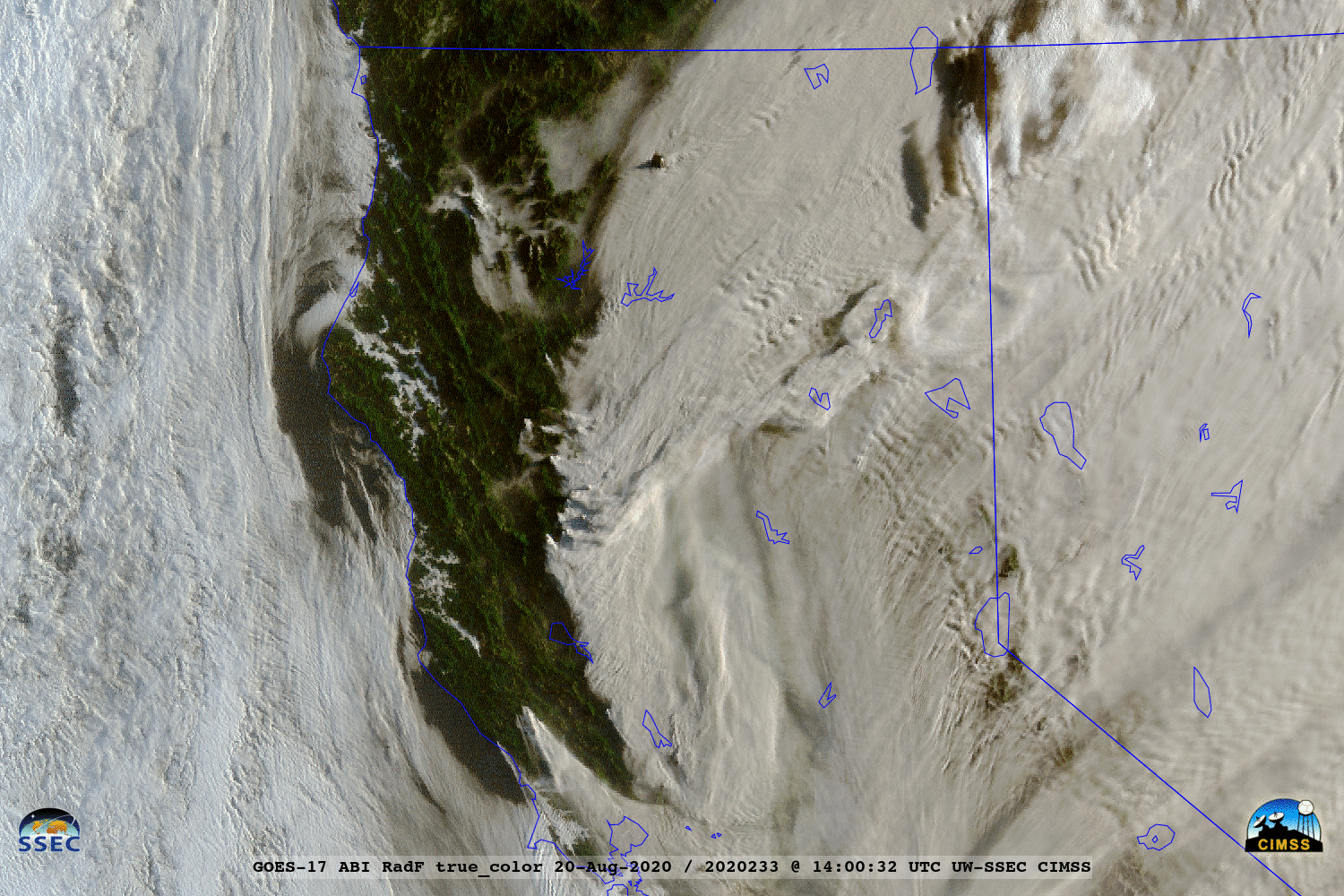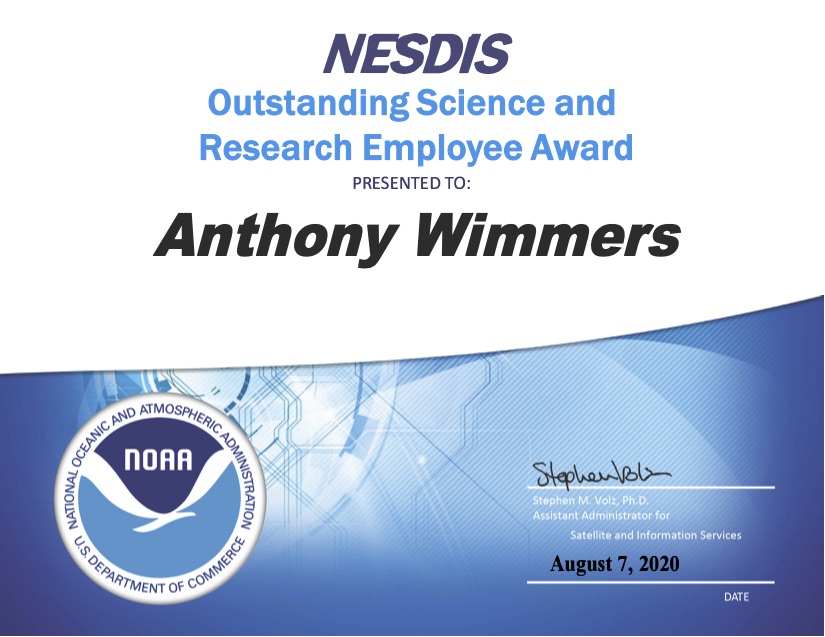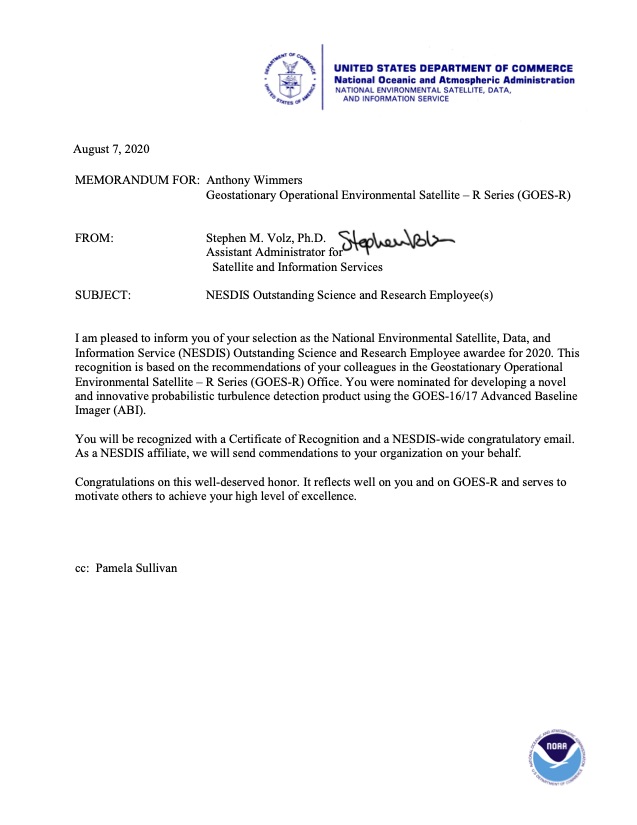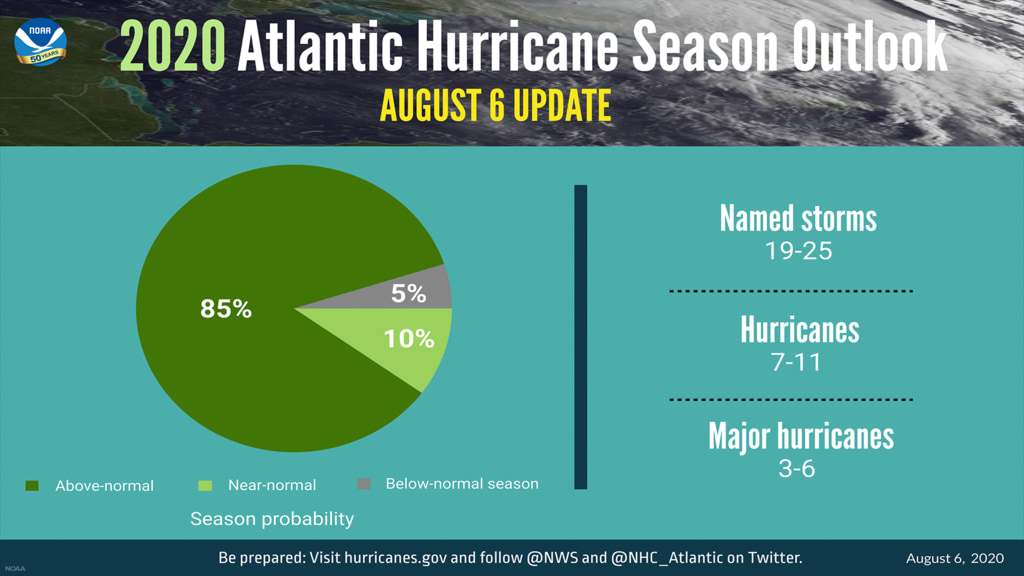
[ Archive ]

 |
CIMSS-NOAA Weekly Report [ Archive ] |
 |
CIMSS AND ASPB WEEKLY HIGHLIGHTS FOR THE WEEK ENDING AUGUST 21, 2020
PRODUCTS AND APPLICATIONS:
CIMSS Fire Algorithm in the News: Google recently announced the availability of near-real-time fire perimeters derived from NOAA and NASA fire products, including the Fire Detection and Characterization (FDC) Algorithm for the Advanced Baseline Imager (ABI) on the Geostationary Operational Environmental Satellite (GOES) series and Active Fires for the Visible Infrared Imaging Radiometer Suite (VIIRS) on the Joint Polar Satellite System (JPSS). The FDC product was developed at the Cooperative Institute for Meteorological Satellite Studies (CIMSS) and is also known as the Wildfire Automated Biomass Burning Algorithm (WFABBA). The FDC provides fire detection and characterization from ABI data. Google consulted with CIMSS scientist and FDC developer Chris Schmidt on use of the FDC data. A description of the methodology can be found at https://medium.com/google-earth/how-to-generate-wildfire-boundary-maps-with-earth-engine-b38eadc97a38. A story on the announcement can be found at https://www.theverge.com/2020/8/20/21376343/google-maps-search-wildfire-boundaries-california. (C. Schmidt, CIMSS, 608-262-7973)
 (Click image to enlarge)
(Click image to enlarge)
Figure: GOES-17 true color imagery provided a closer view of dense residual smoke and new smoke plumes across Northern California on Aug. 20, 2020. Read more: https://go.wisc.edu/85b9n6. Credit: CIMSS, Geo2Grid.
AWARDS AND RECOGNITION:
Tony Wimmers Receives NESDIS Outstanding Research Award: Dr. Anthony (Tony) Wimmers of the University of Wisconsin Cooperative Institute for Meteorological Satellite Studies (UW-CIMSS) was selected as the NESDIS Outstanding Science and Research Employee awardee for 2020. This recognition is based on the recommendations of colleagues in the Geostationary Operational Environmental Satellite – R Series (GOES-R) Office. Tony was nominated for developing a novel and innovative probabilistic turbulence detection product using the GOES-16/17 Advanced Baseline Imager (ABI). (C. Velden, CIMSS, 608-262-9168; D. Lindsey, NESDIS/GOES-R; T. L'Ecuyer, CIMSS, tlecuyer@wisc.edu; T. Schmit, E/RA2, 608-263-0291, tim.j.schmit@noaa.gov; W. Feltz, CIMSS, 608-265-6283)
 (Click image to enlarge)
(Click image to enlarge)
Figure: NESDIS Outstanding Science and Research Employee Award Certificate_Anthony Wimmers.
 (Click image to enlarge)
(Click image to enlarge)
Figure: Award Memo for Anthony Wimmers.
PUBLICATIONS:
Manuscript on Non-Local Thermodynamic Equilibrium Published: A manuscript titled "Improving the Understanding of CrIS FSR Non-Local Thermodynamic Equilibrium Radiances Using Spectral Correlation" was published in JGR-Atmosphere (https://agupubs.onlinelibrary.wiley.com/doi/abs/10.1029/2020JD032710). The co-authors are Zhenglong Li, W. Paul Menzel, James Jung, Agnes Lim, Jun Li, Marco Matricardi, Manuel López‐Puertas, Sergio DeSouza‐Machado, L. Larrabee Strow. This work was supported by CIMSS internal funding. (Zhenglong Li, 608-890-1982, zhenglong.li@ssec.wisc.edu)
WORKSHOPS, CONFERENCES, AND MEETINGS:
TRAINING AND EDUCATION:
VISIT Training on Fog/Low Stratus Detection: Scott Lindstrom from the Cooperative Institute for Meteorological Satellite Studies (CIMSS) presented a live VISIT (Virtual Institute for Satellite Integration Training) teletraining on GOES-R Fog/Low Stratus Products, such as the Probability of Instrument Flight Rules (IFR) Conditions (that is, IFR Probability) and also GOES-16 Cloud Thickness estimates, to forecasters at the National Weather Service office in Charleston, West Virginia (WFO RLX). The GOES-R Fog/Low Stratus products are scheduled to flow over the Satellite Broadcast Network (SBN) to forecast offices starting in early September. Forecast offices now get the fields into their Advanced Weather Interactive Processing System (AWIPS) via an LDM (Local Data Manager) pull from Regional offices (Scott Lindstrom, CIMSS, 608 263 4425)
MEDIA AND OUTREACH:
SSEC and CIMSS Scientists in the News: Scientists at the University of Wisconsin-Madison (UW) Space Science and Engineering Center (SSEC) and the Cooperative Institute for Meteorological Satellite Studies (CIMSS) provide expert commentary, interviews, and imagery to news media and participate in events to promote science. In the news this week: 1) CIMSS hurricane expert Derrick Herndon, along with seven NOAA scientists, participated in a media campaign coordinated by NASA to share with television viewers in top markets how NOAA satellites are helping to better predict this year's active hurricane season. His interviews will air on these stations: WAGA Fox5 (Atlanta, GA), WSMV (Nashville, TN), WKMG (Orlando, FL), WPIX (New York, NY), WHTM (Harrisburg, PA), KSAZ (Phoenix, AZ), KABB (San Antonio, TX), WGBH (Boston, MA), WNYW (New York, NY). 2) CIMSS scientist Leigh Orf talked with HPCWire about why high performance computing is important to resolving small features in supercells and tornadoes: https://go.wisc.edu/03zcf5. 3) CIMSS Satellite Blog contributor Scott Bachmeier published posts on "Wildfires burning across northern California" (Aug. 20), "Hurricane Genevieve in the East Pacific Ocean" (Aug. 18), and "Pyrocumulonimbus clouds in Colorado and California" (Aug. 14). Read more: https://cimss.ssec.wisc.edu/satellite-blog/. (J. Phillips, SSEC, 608-262-8164, D. Herndon, CIMSS, 608-262-6741, L. Orf, CIMSS, 608-890-1983, S. Bachmeier, CIMSS, 608-263-3958)
 (Click image to enlarge)
(Click image to enlarge)
Figure: Graphic used in some interviews with NOAA scientists about the 2020 Atlantic Hurricane season and how NOAA satellites support predictions. Credit: NOAA.
OTHER:
| Archived Weeklies Page | Submit a report item |